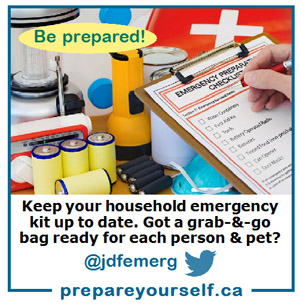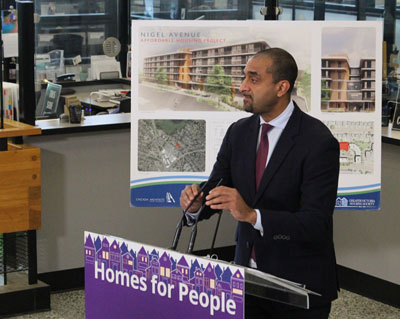
Friday September 29, 2023 | SAANICH, BC | See previous announcement from June 2, 2023 | Last update: October 12, 2023
by Mary P Brooke | Island Social Trends
It was a double-whammy of Housing Minister Ravi Kahlon at media sessions about new housing initiatives this week!
On Tuesday he was hosted by Saanich Mayor Dean Murdock at District of Saanich Municipal Hall.
Today he addressed an outdoor crowd at an affordable housing location with two local MLAs alongside: Minister of Transportation and Infrastructure Rob Fleming (Victoria-Swan Lake) and Grace Lore (Victoria-Beacon Hill). City of Victoria Mayor Marianne Alto also addressed the crowd; her municipality has long been a proponent of affordable housing and trying to find ways to address the housing crisis locally.
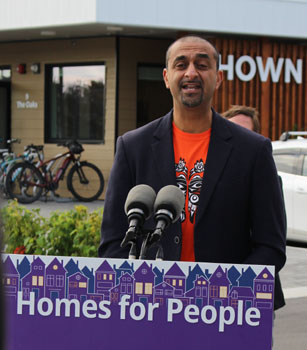
Kahlon in Saanich:
Fleming today reminded folks that Kahlon is Saanich born and raised, and “doesn’t know why he moved to Delta” (a bit of political humour). Kahlon is the MLA for Delta North. Elected in 2017 and 2020, he previously served as the Minister of Jobs, Economic Recovery and Innovation, and before that held several Parliamentary Secretary roles.
Kahlon has been government house leader since Premier David Eby’s cabinet shuffle in December 2022, making him the natural candidate to announce the lineup of legislation for the fall session.
Saanich as ‘ground zero’ for housing plan promo:
Meanwhile, “we’ve found a friend in you” might have been the theme earlier this week at District of Saanich municipal hall, as Kahlon made it clear on Tuesday that Murdock has risen to the occasion in setting a strong leadership tone for other municipalities to get sleeves rolled up and get down to the business of producing more housing in BC.
Saanich is one of three municipalities in the south Vancouver Island area that has been targeted to build a specific number of housing units (across a range of housing types) within a specific time frame. The other two municipalities are the City of Victoria and the District of Oak Bay.
The required number of housing units to be built in those three municipalities are:
- District of Saanich – 4,610
- City of Victoria – 4,902
- District of Oak Bay – 664
[See Saanich, Oak Bay & Victoria heading into housing collaboration with the Province – article from June 2, 2023]
[Update — quote on October 12, 2023: “I’m confident that these targets are the right ones for those communities.”]
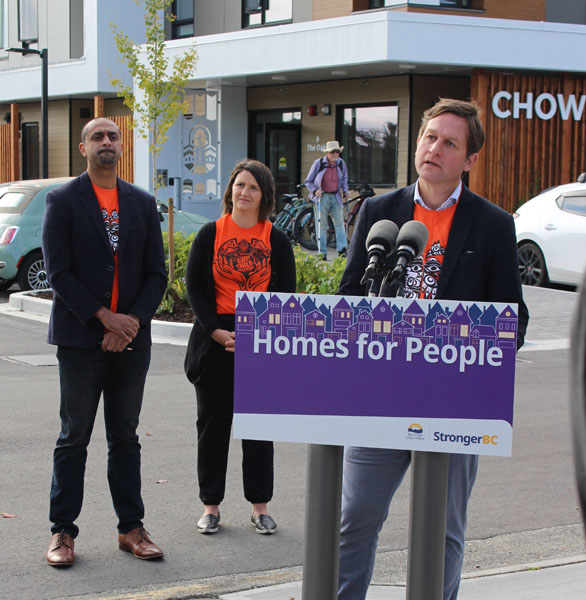
First set of 10:
The first set of identified communities where the BC Government is now expecting to see more attention paid to the creation of more housing supply was released on May 31: Abbotsford, Delta, Kamloops, North Vancouver, Oak Bay, Port Moody, Saanich, Vancouver, Victoria, and West Vancouver.
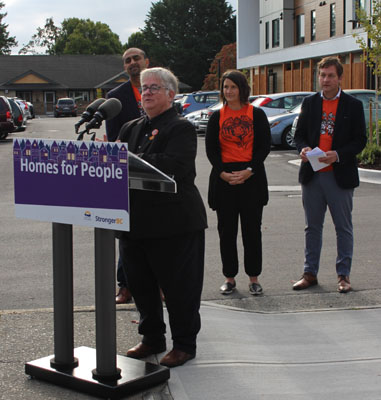
On September 26 they received notification of their quotas from the BC Housing Minister. The target orders for each municipality:
- City of Abbotsford – 7,240 housing units
- City of Delta – 3,607 housing units
- City of Kamloops – 4,236 housing units
- District North Vancouver – 2,838 housing units
- District of Oak Bay – 664 housing units
- City of Port Moody – 1,694 housing units
- District of Saanich – 4,610 housing units
- City of Vancouver – 28,900 housing units
- City of Victoria – 4,902 housing units
- District of West Vancouver – 1,432 housing units
Data-driven targets supported by discussion:
On Tuesday, as soon as BC Housing Minister Ravi Kahlon announced the construction housing targets for the first 10 municipalities on his list, he said the numbers were arrived at based on an amalgam of population growth and housing data, together with discussion and input from the 10 municipalities during the summer months.
The provincial government will check in with the municipalities after six months to see how things are coming along, and then once a year after that.

Housing target guidelines include a recommended number of units by size (one bedroom, two bedroom, three bedroom), rental versus owned units, below-market rental units and units with on-site supports. These guidelines include more than 16,800 below-market rentals.
Key mechanisms for speeding up housing development include improvement of processes for zoning bylaws and streamlining permits.
“Affordable housing is one of our biggest challenges,” said Kahlon at the podium in the Saanich municipal hall mezzanine. He wants to see the new set of housing targets turned into occupied homes. It’s a 10-year strategy which includes more ‘plexes’ (duplexes, triplexes and four-plexes on land previously zoned for single-family dwellings) as well as building homes on municipal land. The strategy includes building homes near transit routes, and taking into consideration (and advocating for) infrastructure that supports homes and communities (e.g. sewers, roads, recreation).
The new BC legislation around housing … which will be rolled out this fall in the BC Legislative Assembly — and all of it likely approved by year-end (as Kahlon said out front of The Oaks on Chown Place affordable housing building in Saanich today) will deal with the impact of short-term rentals on existing housing stock, as well as things that cause construction delays like long approval times and ‘density pushback’. The cost of construction keeps going up in inflationary times; budgeting and financing will need to be quick on its feet. Lack of land opportunity is another factor to grapple with.
The Oaks highlights affordable housing in Saanich:
The new apartment building called The Oaks — at 9 Chown Place — means dozens of families and seniors in Victoria will be able to stay in their community, comfortably and affordably. “British Columbians can expect to see more homes like these open soon as we work to build housing that gives people the peace of mind that comes with safe, secure and affordable housing,” said Kahlon.
The new four-storey wood-frame building has 58 one-, two- and three-bedroom units for people with low to moderate incomes. The building includes one fully accessible unit and 48 adaptable units, as well as a community hall, raised garden beds and a rooftop deck.
“I’m pleased to see the successful completion of The Oaks at 9 Chown Place, with partial funding from the Victoria Housing Reserve,” said City of Victoria Mayor Marianne Alto. “The city is committed to creating more affordable housing and this project is a great example of how, working with the Province and Gorge View Society, we can increase housing options for some of our most vulnerable residents.”
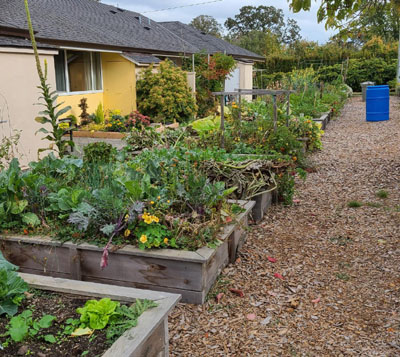
The project is located on a two-hectare (five acres) property owned by the Gorge View Society. Additional housing is expected to be added to the site, further increasing affordable housing options in the coming years. Gorge View Society (GVS) will operate the building.
- The Province, through BC Housing, provided approximately $6.2 million for the project through the Building BC: Community Housing Fund and is providing annual operating funding.
- The Gorge View Society provided the land, valued at $2.2 million, and an equity contribution of $330,000.
- The City of Victoria provided $295,000 through the Victoria Housing Reserve Fund.
Today Minister Kahlon took a quick tour of the affordable seniors housing project.
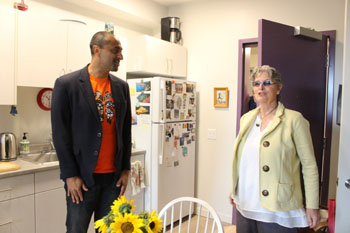
A small unit for one senior is about 414 sq ft, suitable for older folks who are downsizing and appreciate the rent level being 30 percent of their income.
Can’t be left to market sector alone:
“This housing market is challenging,” said Kahlon on Tuesday. But with the provincial and federal governments now stepping up with funding and in the legislation and rules, it’s time for all local government partners to be at the table with solutions, he said.
Surging population growth (250,000 more people in-migrating to BC in 2021 and 2022, and still more coming) is pushing the housing challenge beyond what was already happening pre-pandemic. He singled out seniors and families as particularly needing more housing options and availability — for seniors to age near their families and remain where they have lived and worked, or for younger families to remain where they grew up and continue the family footprint.
Leaving housing development to the private sector alone didn’t work, said Kahlon today. “The market sector can’t build to that level,” he said. For government “to get out of the way” of the market sector to build houses “has led us to this crisis,” Kahlon told the nearly 100 people gathered outside of an affordable housing project on Chown Place in Saanich on this crisp autumn day.
Working with non-profits is key to many of the move-forward projects in affordable housing. Organizations that are “land rich but cash poor” can be part of the solution, said Kahlon. He also pointed out his previous announcement that existing homeowners can develop legal secondary suites in their homes, anywhere now across the province; applicants should be working on their permitting processes now as funding will be released for that program in early 2024.
The short-term rental sector will see stronger enforcement in upcoming legislation. Referring to large corporations like AirBandB and VRBO, Kahlon today said those players “have a role and responsibility to be part of the solution”.
Saanich taking the lead:
“Minister Kahlon and his staff have been so collaborative in their approach. It’s been refreshing to have the opportunity to work together,” said Saanich Mayor Dean Murdock in an interview with Island Social Trends.
“We know it’s going to take all levels of government, it’s going to take non-profit organizations, in order to make a positive difference in terms of housing affordability and availability in our community,” said Murdock.

“From the start we are well-aligned in our agenda to trying to make that happen. We heard numerous announcements from the province in the last couple of weeks that further strengthen our position in order to do that,” said Murdock, who on Tuesday was given accolades by the housing minister for rising to the occasion. “He is one of the strongest leaders in understanding” what needs to be done, said Kahlon about Murdock, i.e. building “more homes for more people more quickly”… “for all incomes and stages of life”.
Some people never expect to own a home — either the housing is just too expensive for their income level, or they choose to free up money to do other things in a chosen lifestyle. So they rent a place to live.
“Our housing needs assessment identified a significant gap in terms of the rental housing supply,” said Mayor Murdock. “We rely extensively on the secondary rental market, meaning mostly secondary suites in primary residences. And so that’s a significant gap where we have a lot of work to do moving forward.”
“We set forward a number of incentives that would entice proponents for land use projects to build more rental housing in the community so we can begin to address that need,” said Murdock. “That’s one way we can ensure that more people can find homes in Saanich,” he said, outlining a range of housing types “across the board” including purpose built rental apartment buildings (construction of which is now GST exempt) and multi-family units (such as duplexes, triplexes, and four-plexes on lots previously zoned for single-family homes).
“Particularly finding family-suitable places in our community is going to be important,” said the 41-year-old Murdock who is in his first term as mayor of the highly populated municipality within the Greater Victoria (capital region) area. Saanich has a population of about 120,600 which is almost one-third of the total capital region population estimated at 400,000 in 2023.
Lots of housing legislation coming this fall:
Housing actions and legislation this fall include:
- delivering more small-scale, multi-unit housing that is within reach for middle-income earners, including townhomes, duplexes and triplexes through zoning changes and proactive partnerships;
- allowing secondary and basement suites in every community in B.C.;
- strengthening enforcement of short-term rentals and bringing more long-term rentals back to the housing market;
- speeding up municipal and provincial permitting to reduce costs, remove unnecessary delays and deliver more homes faster; and,
- delivering thousands of new homes in areas well-served by transit and creating more vibrant communities with services near transit hubs.
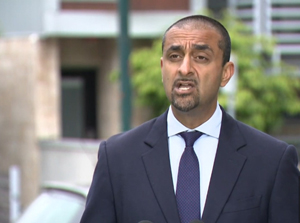
“Put simply, housing supply cannot keep up with the demand,” said Housing Minister Ravi Kahlon earlier this year.
Starting with the communities with the highest need, the province is setting what they acknowledge are ambitious housing targets, in: Abbotsford, Delta, Kamloops, North Vancouver, Oak Bay, Port Moody, Saanich, Vancouver, Victoria, and West Vancouver.
In addition to the 10 municipalities on the May 31 list, there will be 10 more later this year, and a further 10 targeted municipalities in 2024.
===== GOVERNMENT LINKS:
- BC Government new Homes for People action plan: https://news.gov.bc.ca/releases/2023HOUS0019-000436
- Steps the Province is taking to tackle the housing crisis and deliver affordable homes: https://strongerbc.gov.bc.ca/housing/
- Permitting Strategy for Housing:
https://news.gov.bc.ca/releases/2023WLRS0003-000033 - New investments in digital permitting:
https://news.gov.bc.ca/releases/2023HOUS0019-000496 - Backgrounder detailing municipality selection index indicators, visit:
https://news.gov.bc.ca/files/Selection_Index_Indicators.pdf - About the Housing Supply Act, visit:
https://www.bclaws.gov.bc.ca/civix/document/id/bills/billsprevious/3rd42nd:gov43-1
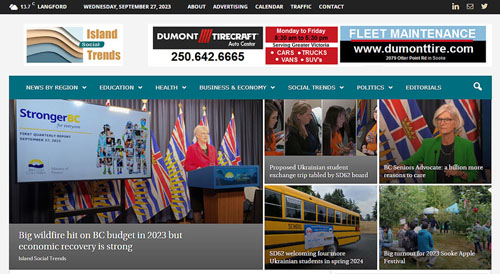
===== RELATED ARTICLES:
Ten municipalities selected for housing supply increase, 20 more to come (May 31, 2023)
BC Indo-Pacific trade mission: diversify trade routes, learn about housing options (May 27, 2023)
Future Ready skills-to-economy matching amidst quarter-million population influx (May 2, 2023)
Refreshed housing action plan will apply BC-wide (April 3, 2023)





